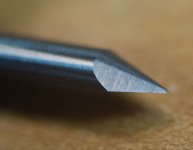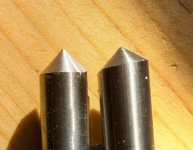Wlodek
Aluminum
- Joined
- Nov 15, 2018
Half round drills are very good at producing accurate, round holes that are as good as reamed holes; I use them especially brass. What is the technique to sharpen those drills? I have a CHRISTEN LC-21 drill grinder that is great for twist drills but obviously cannot be used for half round. I have as well a DECKEL SO single lip grinder. This is producing the right geometry for engraving or milling cutters, but it does not look as or work as well as the original drill. And there isnt any good way to hold those in the Deckel collet. Chucking on the round steam leaves too much overhang especially in small drills. Please note that the tip geometry here is different than gun drill or D bit geometry (that usually does not have clearance).
In the photos: Half round drill, single lip cutter tip as produced by DECKEL, original drill tip



In the photos: Half round drill, single lip cutter tip as produced by DECKEL, original drill tip





 . V block would be the right way of support, though would have to be centred for each size. By the way, centring of the tip is essential to produce an accurate hole, which is the whole purpose of those drills. I am not able to do it accurately enough by hand, we are talking about a few micron range accuracy.
. V block would be the right way of support, though would have to be centred for each size. By the way, centring of the tip is essential to produce an accurate hole, which is the whole purpose of those drills. I am not able to do it accurately enough by hand, we are talking about a few micron range accuracy.
